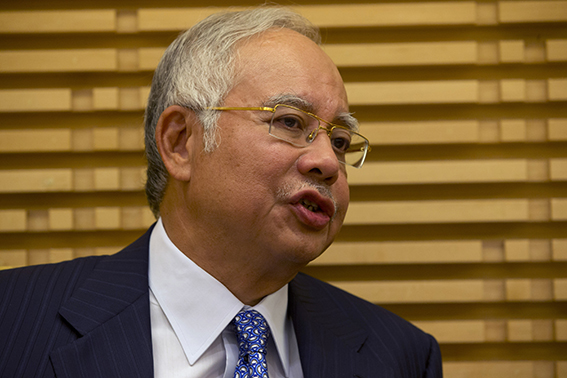The cost for Prime Minister Najib Razak to replenish US dollar holdings has risen to an 11-month high as foreign-exchange reserves slump to the lowest since 2011.
The difference in yield between the nation’s 2.991 percent sukuk due in 2016 and similar-maturity treasuries was 84 basis points, the widest since February, data compiled by Bloomberg show. The securities are one of only three global notes the country has outstanding, which are all Islamic, and the others mature in June this year and in 2021.
Malaysia’s currency has declined to its lowest level in more than five years on concern the drop in crude prices will erode the oil-exporting nation’s current-account surplus. Reserves in Southeast Asia’s third-largest economy have dwindled to $121 billion, versus $157 billion in Thailand and $111 billion in Indonesia.
“Since the spread is expected to widen in the near future and the country’s financial health is weakening, it doesn’t pay for Malaysia to issue dollar sukuk now,” Nizam Idris, head of foreign-exchange and fixed-income strategy at Macquarie Group Ltd. in Singapore, said by phone Monday. “Timing is important and there’s a window of opportunity in the second quarter before the US raises interest rates.”
The central bank told local lenders last month to guard against speculation in the ringgit, which led losses in Asia in 2014 behind the yen. All short-dated transactions requiring the exchange of ringgit for a foreign currency must be backed by documentation, Bank Negara Malaysia said in a Dec. 4 statement.
Concern about the nation’s finances is already starting to show in the local-currency debt market, where global funds reduced holdings of Malaysian government bonds in November by 5.8 percent, the most since September 2011, to 236.5 billion ringgit ($66.9 billion), central bank data showed Dec. 31.
Fiscal Goal
The surplus in Malaysia’s current account, the broadest measure of trade, shrank to 7.6 billion ringgit in the third quarter, the least since the three months through June 2013.
While Malaysia’s foreign-exchange reserves have dwindled, they are still higher than the $91 billion at the end of 2008, when the ringgit dropped 4.6 percent in the midst of the global credit crunch. In 1997-98, when the Asian financial crisis struck, they were as low as $20 billion.
Demand for global Islamic bonds, which pay returns based on assets to comply with a ban on interest, may still be supported this year amid a shortage of supply.
The Bloomberg Malaysian Sukuk Ex-MYR Index, which tracks foreign-currency Shariah-compliant bonds, climbed 5 percent in 2014, a fourth straight annual gain. Worldwide issuance rose 7.4 percent to $46.3 billion, just shy of the unprecedented $46.8 billion in 2012, data compiled by Bloomberg show. Offerings in Malaysia increased 27 percent to 62 billion ringgit.


